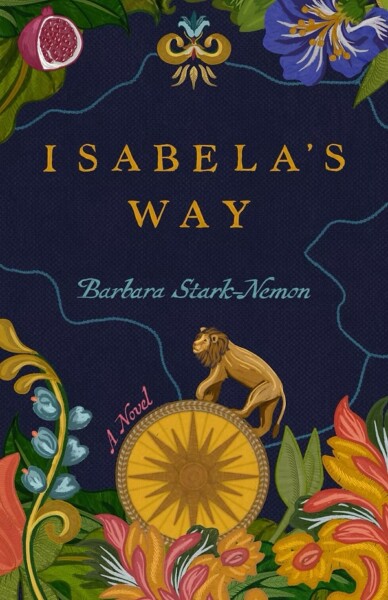Isabella’s Way
by Barbara Stark-Nemon
Reviewed by Ed Lengel

Isabela’s Way: A Novel, by Barbara Stark-Nemon. Berkeley, CA: She Writes Press, 2025.
When French forces invaded and began their long colonization of North Africa after 1830, they expected to encounter a variety of Islamic civilizations, some fairly recent—a thousand years old, or so—and some ancient, stretching all the way back to Roman and pre-Roman times. And so they did. The French were surprised, though, to encounter two much-despised and oppressed underclasses, who turned to them for help. One group, called the “Moors,” were descendants of refugees from Al-Andalus, or the old Islamic kingdoms of Spain and Portugal, finally driven out in the course of the Christian Reconquista of the Iberian Peninsula that culminated in 1492. Though Muslim, these people were treated as morally suspect foreigners and so remained a distinct underclass in North Africa.
Far worse off were the Jews. These people, descendants of historic Jewish communities, especially from Spain and Portugal, but also from other parts of Europe, had also been driven out by the Reconquista, or by pogroms and expulsions of Jewish communities that happened in other parts of Europe at various times throughout the Middle Ages. In North Africa, these communities were also persecuted, but at least they were allowed to live–with the exception of the pogroms–that also broke out there from time to time. When the French arrived, Muslim Berbers and Arabs vented their rage by carrying out numerous massacres of Jewish communities throughout the region. But where else could the Jewish people go?
Isabela’s Way reveals the plight of Iberian Jews who chose another path—one of many, but all dangerous—to survival. The Christian “purification” of Iberia that coincided with and followed the Reconquista allowed one loophole: Muslims and Jews who renounced their faiths and converted to Catholic Christianity could stay. Many avail themselves of the opportunity rather than leaving their ancestral homes and converted. Inevitably, however, many did so only nominally. Growing increasingly aware of this apparent problem, the Catholic Church devised the Inquisition as a means of rooting out those who had converted only nominally and remained secret Muslims or Jews. Also inevitably, the Inquisition became a simultaneous tool for fanaticism—identifying and destroying not just the obviously insincere, but anyone who was “impure”—and for vindictive hatreds, as neighbors preyed upon neighbors, reporting rivals to the Inquisition for investigation, and possibly torture and death.
For New Christians, or Conversos—Jews, whether sincere converts or not—it was impossible to evade the line of fire for long. Isabela’s Way tells the story of one such community, at Abrantes in central Portugal northeast of Lisbon, that in 1605 discovers itself becoming the target for persecution and possible eradication. Isabela de Castro Nuñez is a fourteen-year-old girl whose mother has died of the plague, and whose father, Gabril, has traveled abroad in search of a place of refuge for the New Christian community in Abrantes. Isabela, who makes her living by working in embroidery, naturally resists change, hoping she can somehow ignore the Inquisition and remain in Abrantes with family and friends. As the danger increases and her father sends a message that escape is imperative, however, Isabela bravely faces the truth and begins her journey.
It is not a solitary one. Leaving Abrantes, Isabela joins other Jews in following an underground network, similar to the famed Underground Railroad of the Civil War-era United States, to seek a route to safety that Gabril has discovered in Hamburg in northern Germany. The way is fraught with danger, as for various reasons people threaten to betray the escapees to the Inquisition. Also, in this era Europe is besieged with internal divisions, political and social unrest, and war that will soon (in 1618) lead to the outbreak of the devastating Thirty Years’ War. Isabela navigates through all of these dangers, and more, as she moves from point to point across Spain, France, Northern Italy, Flanders, and finally to Hamburg.
This is a coming-of-age story, and so Isabela becomes wiser, more mature, more intrepid as her adventures, with numerous narrow-miss escapes—unfold. Embroidery for her becomes a means of earning a living, but also of artistic expression, and a means of communication, including secret messages conveying paths of escape. One of her neighbors in Abrantes, eighteen-year-old David de Sousa, and his family share many of Isabela’s trials and adventures. Their relationship ramps up into eventual intimacy. All of the characters in this novel are richly drawn, with a searching eye toward their humanity.
The novel’s conclusion contains a hidden, but nevertheless telling irony, as Isabela and David arrive in Hamburg in 1606, discovering union with each other and hoping for peace for their communities. Over the following three hundred years, their descendants would know good times and bad. Always, though, they would live under a shadow; and the tough times would become bad indeed, for nowhere in Europe was entirely free of pogroms and persecutions victimizing anyone of Jewish ancestry, secular or not. And it was in Germany, finally, Nazism would take root, and the Holocaust would begin.
Ed Lengel is an author, a speaker, and a storyteller.




